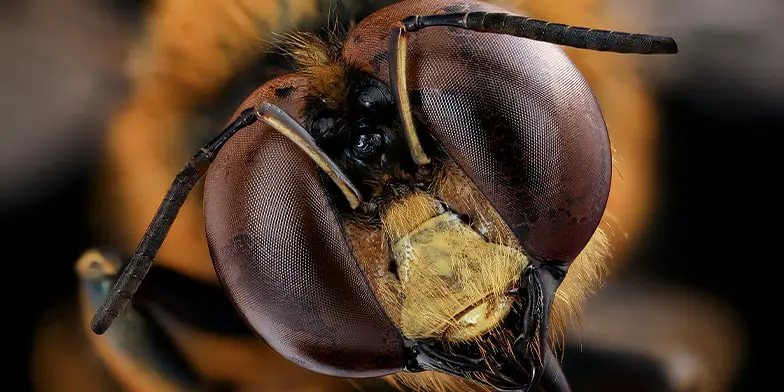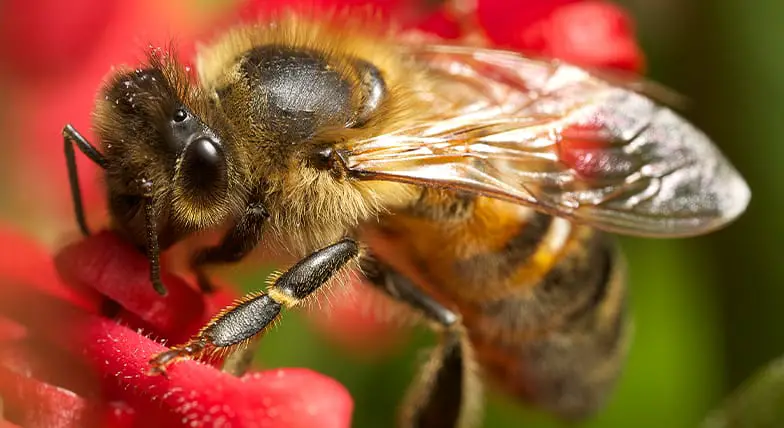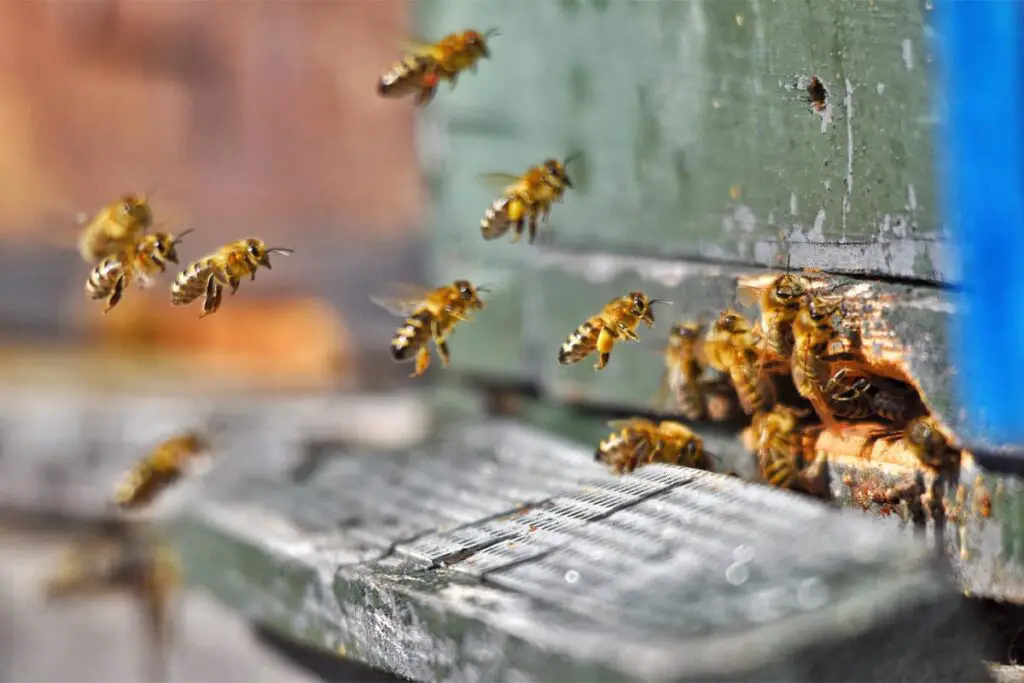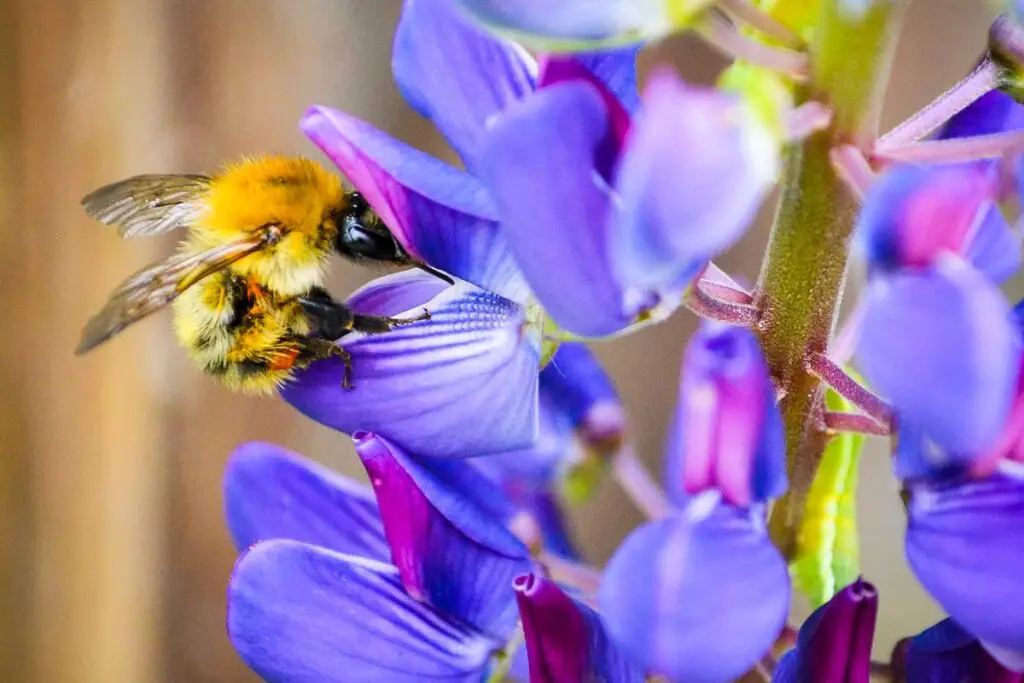
Bees are wonderful creatures, and they have a range of unique features they use to survive in this dangerous world. One of the most interesting parts of their body structure is their eyes, of which they have five. Unlike many insects you’d commonly see that have two compound eyes, what makes bees so special? The answer lies in how they work for food and protection.
Bees have five eyes to best detect the colors and shapes of their natural environment, including the ultraviolet markings they depend on for nectar. The wide angle view of eyes on their sides are to spot sources of food and predators, whereas the three eyes at their front are used for navigation.
The vision of the bee is fascinating, and they view the world differently than most animals. You might be surprised at the intricacy and efficiency of how the bee sees the world. They may be small, but in several ways their vision is better than ours.
How Do Bees See The World?
The compound eyes of a bee have a very wide field of view, which from an aerial perspective will cover most of the land below. Bees also have a wider band of visible light than humans, which means they can see colors that we can’t perceive.
Using the compound eyes on the sides of their head, bees can see ultraviolet light. They use this power to detect the level of nectar on each flower, as they are able to detect patterns in flowers that we are unable to see. This is one of the reasons bees are successful in quickly searching for nectar-rich flowers. This also reveals how they can find specific flowers so successfully in the visual chaos that is a garden or meadow.
Bees also have three single-lens ocelli, simple eyes that help them navigate and see at distance. As these eyes have a very high flicker threshold, they can see objects faster than many other animals and insects, which means they’re vital for perceiving the world even if the bee is travelling really fast.

Bees are also sensitive to changes in view direction as they navigate the world, because it can result in an effect called iridescence, where the color of an object will appear to change based on the viewing angle. Flowers will present this way to be more appealing to pollinating insects.
This is a feature more pronounced in the ultraviolet spectrum, and to a bee the colors of a flower appear are far more vibrantly. As we’ve already discussed previously on Bug Domain, attracting bees (and other pollinators) is a key part of many flower’s reproduction cycle.
You may wonder how bees see the world at night. They can enlarge their compound eyes to have a clear view, even in very low-light situations. Larger bees can see better at night because they have increased numbers of ommatidia in their compound eyes. They can also see patterns in polarized light, which makes searching for nectar much easier!
Do Bees Have Good Vision?
For what they intend to achieve, bees have fantastic vision. With a combination of their ocelli and compound eyes, they can cover every detail of their environment and navigate at speed without difficulty. That said, their eyesight is no way near as clear as human vision.
If you’re wondering if bees have good vision, I think it’s important to remember to judge their eyesight within the context of their daily lives. Perhaps a more apt question would be do bees have good vision for what they need to do? The answer is a definitive yes.
Bees work continually to ensure the survival of their colony. They have to leave the hive to collect food, and during their explorations predators are a significant threat. To help scan for potential attackers, the compound eyes of a bee provide them with a range of vision of 280 degrees. This is well over double the average human vision span of 120 degrees.
Using all 5 of their eyes in combination, bees have a very good sense of space, which is necessary for high-speed aerial navigation. Their vision supports a three-dimension image with depth perception. By processing the input from their eyes, they can calculate distance, whether that’s for the perfect landing, to communicate with other bees in the swarm, or to find nearby nectar.
If you want to see real-life proof that bees have good vision, take some time to observe one as it explores your garden. Watch how it delicately yet deliberately navigates around obstacles, and lands exactly where it intends. Most of the time, anyway.
Do Bees See Better Than Humans?
The vision of a bee has a much wider perceptual span than the average human (280 for a bee, 120 for humans), and unlike us bees can see into the ultraviolet spectrum. These are where the advantages of their sight stop however, as human eyesight creates a far clearer picture.
The clarity of bee eyesight is very poor compared to that of a human. If we can compare their vision in terms of digital resolution, the vision of a bee would be around 13 Kilopixels. On the other hand, human vision can be placed at around 580 Megapixels.
That’s approximately 4,461 times more information.
The bee has sacrificed that clarity to take in more of their surrounding environment during flight.
Can Bees See Color?
Bees can see color, but not in the same way as other animals might. The eyes of a bee are not as sophisticated as human eyes, and are mostly sensitive to blues and purples. They see the color red as black, and will also have difficulty differentiating between other shades of red, like orange or maroon.
Although bees have a wide range of color vision, they are unable to see a large number colors that humans can perceive. To get a little scientific, the eyes of a bee contain approximately 7000 facets, which are connected to tubes called ommatidium. Each of these tubes contain 8 cells that are sensitive to different hues of light.
To break it down, 4 of those 8 cells in each ommatidium inside their eyes are sensitive to green and yellow. Similarly, two of the cells are responsive to the color blue. The remaining two cells are sensitive to the ultraviolet spectrum.
Working together, those represent the range of colors that the compound eyes of a bee can perceive. These eyes can see color in a range of 300 to 500 nanometers. For some context, humans can see between 380 and 700 nanometers.

Why Do Bees Have Hair On Their Eyes?
The hairs located on a bee’s eyes help it fly in harsh conditions. It helps them navigate better, as the nerve endings connected to the hair are sensitive to the wind. The sensation of the force the wind exerts helps them to steer in the right direction.
This dense layer of hair also protects the bee’s eyes from damage. The hairs help prevent pollen grains from touching the sensitive surface of the eye itself, and aid in removal as the grains inevitably get stuck to their bodies as they extract nectar.
A bee coated in pollen will struggle to return to their hive, as the uneven weight makes flying difficult. The hair on their eyes will catch this pollen, and make it easy to transfer into little baskets on their hind legs called corbiculae.
These hairs don’t provide complete protection. Some small particles of the pollen grain may slip into the hair spaces. In such cases, it may be difficult for the hairs to get rid of it to help the bees, and they’ll have to clean themselves properly.
Conclusion
I hope now you have a stronger understanding of why bees need all 5 of their eyes to survive and thrive in the wild outdoors. Thanks for reading, and I wish you good luck in your further research of these fascinating little insects.
Driven by a passion for those tiny creatures that rule our world, we at Bug Domain strive to be your go-to resource for information on insects.



